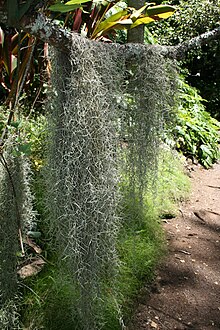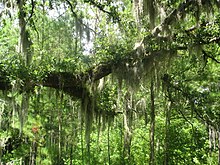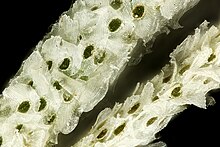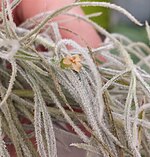
An epiphyte is a plant or plant-like organism that grows on the surface of another plant and derives its moisture and nutrients from the air, rain, water or from debris accumulating around it. The plants on which epiphytes grow are called phorophytes. Epiphytes take part in nutrient cycles and add to both the diversity and biomass of the ecosystem in which they occur, like any other organism. They are an important source of food for many species. Typically, the older parts of a plant will have more epiphytes growing on them. Epiphytes differ from parasites in that they grow on other plants for physical support and do not necessarily affect the host negatively. An organism that grows on another organism that is not a plant may be called an epibiont. Epiphytes are usually found in the temperate zone or in the tropics. Epiphyte species make good houseplants due to their minimal water and soil requirements. Epiphytes provide a rich and diverse habitat for other organisms including animals, fungi, bacteria, and myxomycetes.

The Bromeliaceae are a family of monocot flowering plants of about 80 genera and 3700 known species, native mainly to the tropical Americas, with several species found in the American subtropics and one in tropical west Africa, Pitcairnia feliciana.

Tillandsia is a genus of around 650 species of evergreen, perennial flowering plants in the family Bromeliaceae, native to the forests, mountains and deserts of the Neotropics, from northern Mexico and the southeastern United States to Mesoamerica and the Caribbean to central Argentina. Their leaves, more or less silvery in color, are covered with specialized cells (trichomes) capable of rapidly absorbing water that gathers on them.

Taxodium mucronatum, commonly known as Montezuma bald cypress, Montezuma cypress, or ahuehuete, is a species of Taxodium that is primarily native to Mexico and Guatemala, with a few populations in the southwestern United States. Ahuehuete is derived from the Nahuatl name for the tree, āhuēhuētl, which means "upright drum in water" or "old man of the water."

Usnea is a genus of mostly pale grayish-green fruticose lichens that grow like leafless mini-shrubs or tassels anchored on bark or twigs. The genus is in the family Parmeliaceae. It grows all over the world. Members of the genus are commonly called old man's beard, beard lichen, or beard moss.
Old man's beard may refer to the following:

Tillandsia recurvata, commonly known as small ballmoss or ball moss, is a flowering plant in the family Bromeliaceae that grows upon larger host plants. It grows well in areas with low light, little airflow, and high humidity, which is commonly provided by southern shade trees, often the southern live oak. It is not a parasite like mistletoe, but an epiphyte like its relative Spanish moss.
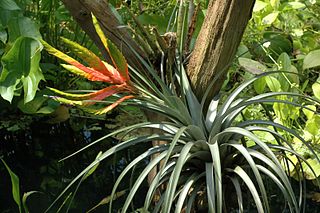
Tillandsioideae is a subfamily of plants in the bromeliad family Bromeliaceae. This subfamily contains the greatest number of species. Most are epiphytic or lithophytic, growing in trees or on rocks where they absorb water and nutrients from the air. Spanish moss of the genus Tillandsia is a well-known species. Bromeliads in the genera Guzmania and Vriesea are the more commonly cultivated members of this subfamily.

Tillandsia balbisiana, common name northern needleleaf, is a species of bromeliad in the genus Tillandsia. This species in native to Mexico, Central America, Colombia, Venezuela, the West Indies, and Florida.

Tillandsia xerographica is a species of flowering plant in the bromeliad family. It is native to southern Mexico, El Salvador, Guatemala and Honduras. The name is derived from the Greek words ξηρός (xeros), meaning "dry", and γραφία (graphia), meaning "writing". It is included in Tillandsia subg. Tillandsia.

Tillandsia brachycaulos is a species of flowering plant in the genus Tillandsia. It is native to Mexico, Central America, and Venezuela.
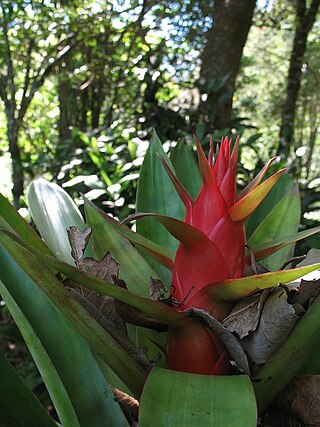
Tillandsia imperialis is an epiphytic species of flowering plant in the genus Tillandsia. This species is endemic to Mexico, specifically the states Hidalgo, Oaxaca, Puebla, Querétaro, and Veracruz, at elevations ranging from 800 to 2,600 meters. Its distribution is generally on the eastern portion of the eastern Sierra Madre Mountains and the eastern portion of the Trans-Mexican Volcanic Belt. This species is primarily epiphytic to the branches and holes of the tree species Pinus patula and Quercus laurina, or on lianas of the same trees, in moist cloud forests. This bromeliad prefers moist conditions and does not tolerate extended periods of drought or low humidity.

Tillandsia fasciculata, commonly known as the giant airplant, giant wild pine, or cardinal airplant, is a species of bromeliad that is native to Central America, Mexico, the West Indies, northern South America, and the southeastern United States. Within the United States, this airplant is at risk of extirpation from the Mexican bromeliad weevil, Metamasius callizona. A related plant, Tillandsia utriculata, sometimes called the "wild pine", is endemic to the same areas.
Tillandsia festucoides, commonly known as the fescue airplant, is a species of bromeliad that is native to the Greater Antilles, Mexico, the Cayman Islands, and Central America.
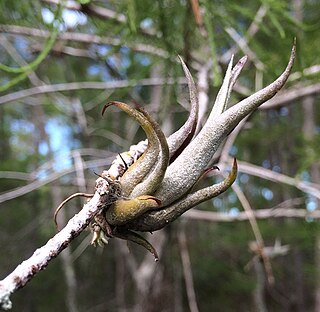
Tillandsia paucifolia, the potbelly airplant, is a species of bromeliad in the genus Tillandsia. This species is native to Central America, central and southern Mexico, Venezuela, Colombia, the West Indies, and Florida.

Tillandsia schiedeana is a species of flowering plant in the genus Tillandsia. It was named for the collector Christian Julius Wilhelm Schiede. As an epiphyte, it is found "growing in open tropical forests, and saxicolous, growing on cacti and burseras on steep dry slopes in semiarid regions in Mexico, Central America, West Indies, Venezuela, and Colombia at elevations of 750 to 5,500 feet."
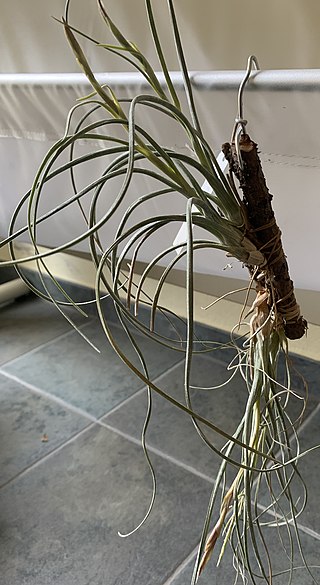
Tillandsia baileyi, commonly known as the reflexed airplant or Bailey's ball moss, is a species of bromeliad that is native to southern Texas in the United States and Tamaulipas in Mexico. It is found along the Gulf of Mexico from Kingsville, Texas to Tampico, Tamaulipas. Preferred host plants for this epiphyte include Southern live oak and Texas ebony.

Tillandsia kammii is a species in the genus Tillandsia that is native to Honduras, but has also been collected in El Salvador. It was first discovered in Honduras in 1977 in the regions of Olancho, Lempira and Copan. Its common name is Kamm's tillandsia.

Tillandsia ultima is a species of flowering plant in the genus Tillandsia that is native to Colombia and Ecuador. It was first discovered in Colombia in 1946 in the region of Magdalena.
